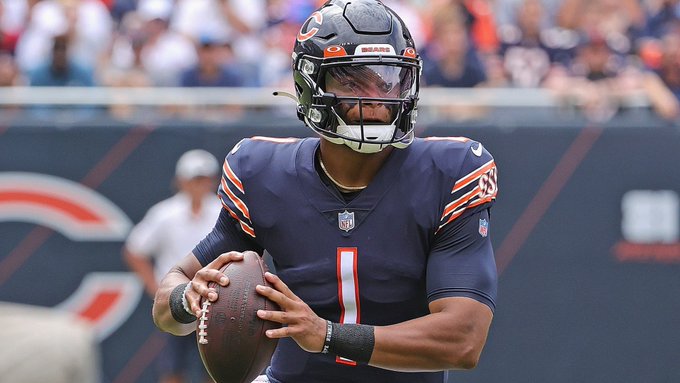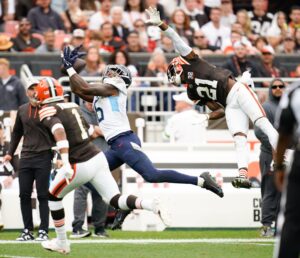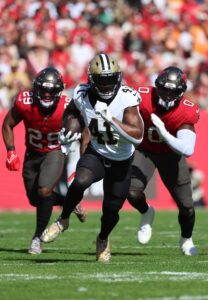Every year leading up to the NFL draft, fans and analysts are inundated with the takes that teams simply should not draft certain positions from certain schools. With the evolution of the Ohio State offense, they have had quarterbacks drafted high. With C.J. Stroud and the hype surrounding him, the takes of “Ohio State quarterbacks in the NFL never work!” emerge.
Over the past five drafts, Ohio State has sent its last three starting quarterbacks to the NFL via the first round. As the dust settled, Stroud was the second-overall pick by way of the Houston Texans. Saying to avoid Ohio State quarterbacks is lazy, there’s no way around it. Scout the player, not the helmet.
Addressing the “Ohio State Quarterbacks in the NFL Never Work” Opinion
Comparing Eras is Pointless
To start, the NFL has changed over the years. Gone are the days of ground and pound, save for a couple of teams. Back in Woody Hayes’ days, he didn’t need an NFL-ready quarterback to win because that just was not his philosophy. It was the same in the NFL. Do fans truly believe that Joe Namath, Jim McMahon, or Jim Plunkett could succeed in today’s game?
Ohio State did not develop NFL-ready quarterbacks until Ryan Day came to town because they did not need to. Their philosophy was not unlike those of NFL teams at the time: run the ball and play physical defense. If Lamar Jackson played in the 1970s, he would likely be regarded as one of the greatest quarterbacks of all time.
Bringing up Ohio State quarterbacks in the NFL like Bobby Hoying, Troy Smith, Craig Krenzel, or Joe Germaine when discussing players like Justin Fields or Stroud is pointless. The offenses the former signal callers played in did not ask nearly as much of its quarterbacks as the current Ohio State system. Ryan Day’s offense is heavily influenced by his time in the NFL and is considered to be very pro-style.
The thing I love about CJ Stroud is he’s not afraid of the bright lights
Everybody talks about the Semifinals against Georgia but the Rose Bowl was as impressive down Garrett Wilson and Chris Olave (37/46 573 6TD/1 INT)
Just bucket throws everywhere
pic.twitter.com/tFVV6my6Jv— Joe O’Leary (@TheHQNerd) March 13, 2023
Take Troy Smith for example. Smith won the Heisman Trophy after the 2006 season and was drafted by the Baltimore Ravens in the fifth round. At the time, his size was a liability despite his strong arm and ability to make defenders miss. Fast-forward to 2018 and a player with a very similar profile was drafted first overall. Baker Mayfield was nearly the same height, same weight, similar arm strength, and was known for making plays with his legs. Put Smith in Lincoln Riley’s offense and Mayfield in Jim Tressel’s offense and what would happen?
Football has changed, drastically. Holding the inability to make it in the NFL of quarterbacks two or more decades ago against players throwing over 4,400 yards and 44 touchdowns in a season is lazy and pointless.
Defining “Bust”
In the NFL, 53-man rosters are made up of players selected at all points in the draft as well as a number of undrafted free agents. If Tom Brady hadn’t panned out, would he have been considered a bust? No, a player selected 199th overall has little-to-no expectations. That’s why it is important to define “bust” when it comes to Ohio State quarterbacks in the NFL.
According to Bleacher Report’s Scott Kacsmar:
“You cannot just call every player who does not pan out an NFL bust…This is why the bust label has often been saved for players drafted in the first round, because those players come with actual expectations. “
Before Stroud, Ohio State had only had four first-round quarterbacks taken: Don Scott (fourth-overall to the Chicago Bears in 1941), Art Schlicter (fourth-overall to the then-Baltimore Colts in 1983), Dwayne Haskins (15th-overall to the then-Washington Redskins in 2019), and Justin Fields (11th-overall to the Chicago Bears in 2021). Stroud became the fifth in 2023, going second overall.
The idea that “Ohio State doesn’t develop NFL-ready quarterbacks” could be a more accurate idea up until the Ryan Day era. To call every single Ohio State quarterback in the NFL a bust would be inaccurate at the very least.
Not All Situations Are Alike
A quarterback’s talent plays a big part in whether or not they make it at the next level. If a quarterback just can’t play, they will not make it, plain and simple. However, another massive contributor to a quarterback’s fate is where said player lands. Back in 2020, there were debates that Joe Burrow should refuse to play for the Cincinnati Bengals because they are a poorly-run franchise. Obviously, after back-to-back AFC North titles, that has not come to fruition. But not every quarterback is so lucky.
Take the late Dwayne Haskins for example. Haskins was the most prolific passer in Ohio State history in his lone season as a starter and was drafted high by Washington. Despite his draft position, he was never actually given a shot to succeed. Were there immaturity issues? Of course, but so have there been with numerous others. The issue was that his head coach at the time, Jay Gruden, simply did not want him.
Dwayne Haskins = Josh Rosen (situation-wise)
Little time to develop. Not given enough of an opportunity. Played with multiple different coaches. Didn't get a chance to learn a consistent system.
Unfortunate for some of these young guys.
— Zack Patraw (@esiZack) October 7, 2020
As a rookie, Haskins started his first game in Week 9 and started the next six games, passing for a total of 1,365 yards, seven touchdowns, and seven interceptions. Elite? No. Worth the scorn? Definitely not. The next year, he started off the year as QB1, starting the first four games, and passed for 939 yards, four touchdowns, and three interceptions. He was then benched for breaking COVID-19 protocols and was a backup until Weeks 15 and 16 when he made his final two starts of his career. Meanwhile, Daniel Jones is still a starting quarterback in the NFL (and was rewarded with a second contract) despite hardly being a top-20 quarterback in the NFL.
There is a similar situation in Chicago with Justin Fields. Fields had a meh rookie year when he passed for 1,870 yards, seven touchdowns, and 10 interceptions in 10 games. In his second year, he threw for 2,242 yards and 17 touchdowns compared to 11 interceptions. On the ground, Fields has shown how much of a playmaker he is, developing into one of the best rushing quarterbacks in the NFL. He is their quarterback of the future, but has Chicago done anything to support him? Cincinnati drafted Ja’Marr Chase and added three offensive linemen to help Joe Burrow. Miami also invested in the offensive line, drafted Jaylen Waddle, and traded for Tyreek Hill to help Tua Tagovailoa. Chicago hasn’t done anything to help Fields to this point.
Fit and franchise competency matter.
Justin Fields did 79% of his throws by way of natural drop back. That was terrible to put a rookie QB in that situation especially when he isn't a drop-back passer.
The new offense will get him moving as he should.— Larry Horn (@larryhornSR) August 4, 2022
Verdict
Don Scott: N/A
Scott was drafted high by the Bears but went off to serve in World War II. His plane crashed in England and he passed away at the age of 23. Not exactly fair to call Scott a bust when he died serving our country in World War II, and thus never actually got to play.
Art Schlicter: 100% Bust
Schlicter was the greatest quarterback in Ohio State history at the time of his graduation. He finished top-six in Heisman voting in his final three seasons. Schlicter finished his Ohio State career with 7,547 yards, 50 touchdowns, and 47 interceptions in four years. However, he was a known gambling addict.
At Ohio State, he frequented Scioto Downs, the local horse racing arena. He then went on to gamble on both collegiate and professional football games. It was covered up by then-coach Earl Bruce. After getting drafted, he was beaten out by a fourth-round pick and continued to gamble unmercifully. His signing bonus was reportedly gone by mid-season and he never quit. Over his short-lived NFL career, he gambled away millions and ended up suspended. He is 100% a bust.
Dwayne Haskins: N/A
This could be considered a hot take by some but Dwayne Haskins was never given a legitimate shot to succeed in the NFL. To start, his coach never wanted him. Then, his leash was incredibly short with Ron Rivera in his second year. Quarterbacks like Daniel Jones and Tagovailoa have not been great but still have jobs. If the New York Giants had done what 98% of draft analysts expected and drafted Haskins, perhaps he would have had a job for longer.
Justin Fields: TBD
The jury is still out on Fields considering he has only played two years. He has the skill to overcome the deficiencies of the Bears front office but will he have the opportunity? Freeing him from Matt Nagy helped, but the jury is still out on whether or not Fields will be a success or bust. He took a big step forward in his development in his second year but 2023 will be a massive indicator if he’s here to stay.
Scout the Player, Not the Helmet
Best passer rating by a Big 10 QB in a season since 2014:
🥇 Justin Fields (2019) – 131.0
🥈 CJ Stroud (2021) – 130.8
🥉 Dwayne Haskins (2018) – 122.9 pic.twitter.com/qrzby9kvUg— PFF College (@PFF_College) June 5, 2022
Asserting that Ohio State quarterbacks in the NFL don’t work simply due to a few instances is lazy. Take the top five 2023 NFL Draft quarterbacks: Stroud, Bryce Young, Will Levis, and Anthony Richardson.
- Stroud has already been discussed.
- Who was the last great Alabama quarterback? Jury is out on Tagovailoa and Mac Jones, so Joe Namath? Debatable.
- Has Kentucky ever had a successful NFL quarterback?
- Richardson is doomed to be Tim Tebow since they both went to Florida, right?
Asinine statements can seemingly be made about almost generational talent in every draft. Looking at this year’s draft, fans and analysts can nitpick every top pick. Damning a player based on their college is just plain lazy. Teams need to evaluate the player for what they are. Saying that every one of the Ohio State quarterbacks in the NFL is a bust is reductive.
True or False: Justin Fields will have a breakout season in 2022 ✍️ pic.twitter.com/7DhQ8F6lL5
— Beerly Football (@BeerlyFootball) June 2, 2022
Heading into 2023, there will be 32 starting quarterbacks (going by the one leading the team in starts in 2022 and assuming Stroud, Richardson, and Young are their team’s starters) in the NFL hailing from 25 different schools. Alabama and Oklahoma lead the way with three each. After them, Ohio State, Clemson, and California have two each. For example, the three from Oklahoma were coached by Lincoln Riley. Before him, Oklahoma was not known as a quarterback factory. They had Sam Bradford and that was it. The Ryan Day era at Ohio State could be akin to Oklahoma’s Lincoln Riley era.
Now that Stroud was drafted second overall and whoever takes snaps for the Buckeyes this fall is expected to be great, it’s possible.
Fans, analysts, and teams need to do better.






